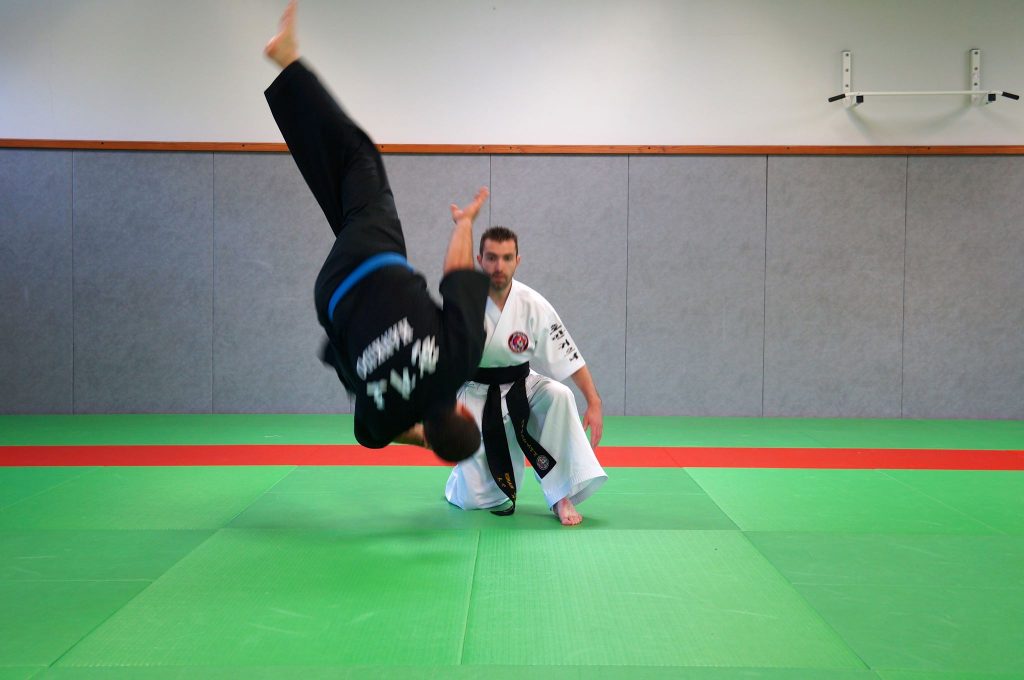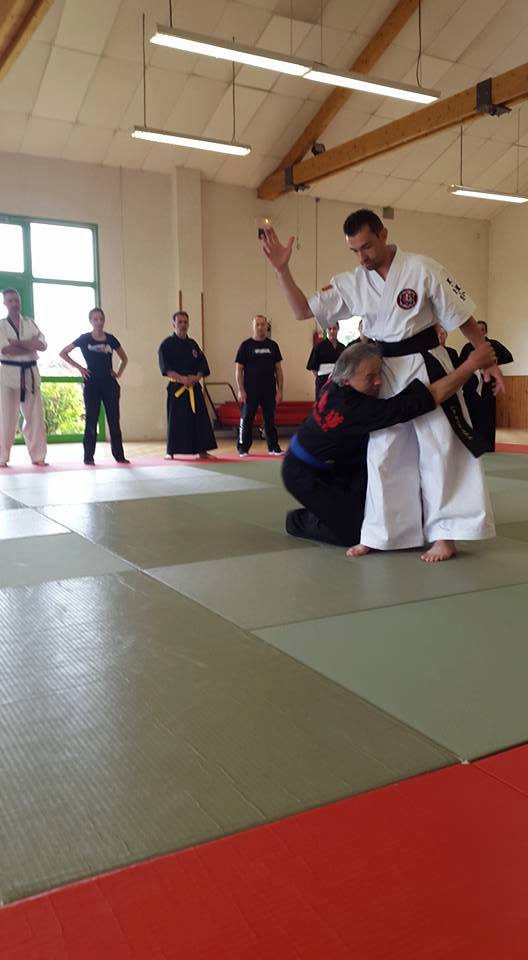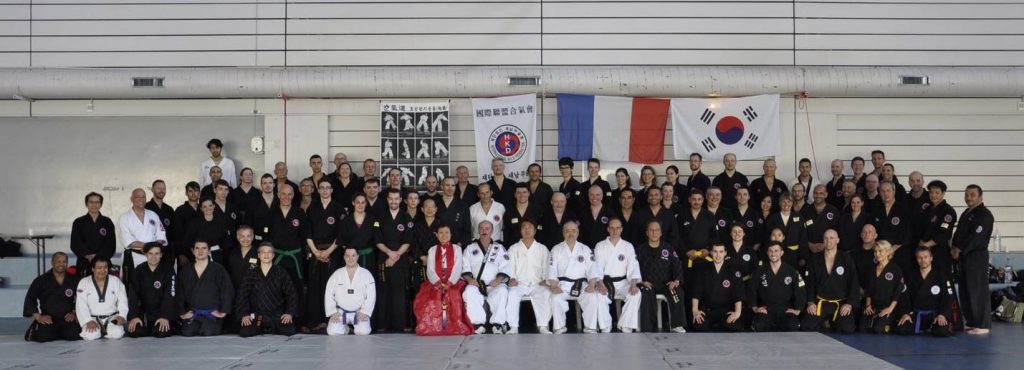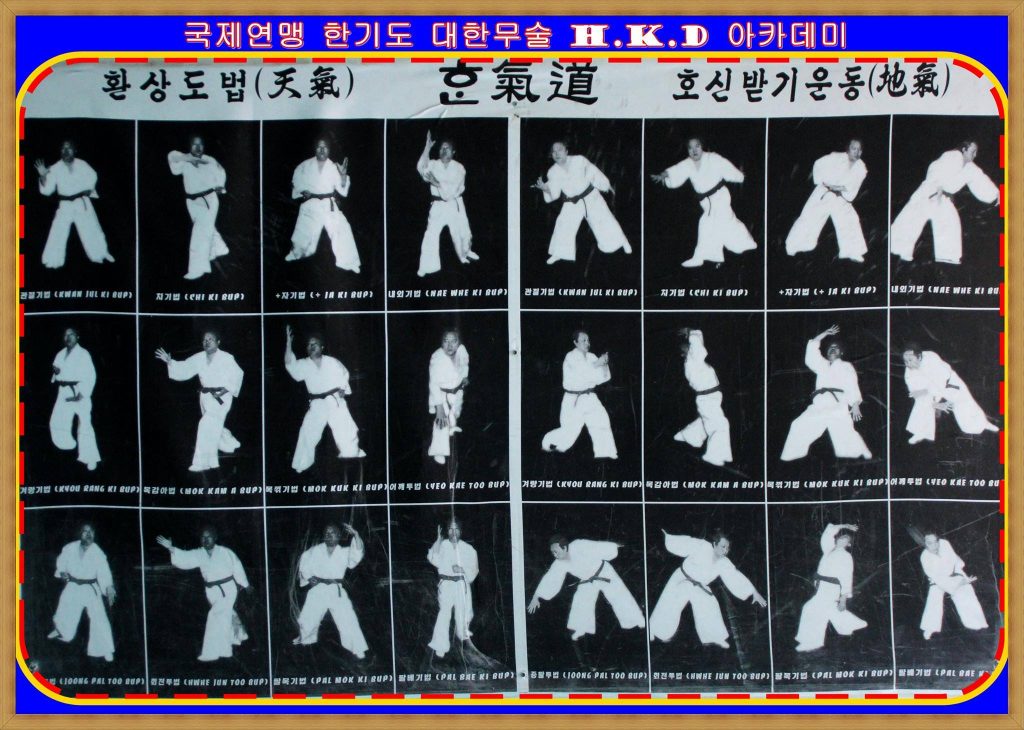Romain has been practicing martial arts for more than 15 years. In 2005 he discovered Hapkido and Hankido that he teaches today in Nort sur Erdre (France). Despite a genetic disease that affects his sight, Romain made an early choice to go for a subtle practice, based on sensation, which he completed by learning manual therapy via Reiki and Shiatsu.
Romain came to Hong Kong in 2013 to share his great knowledge with us. Today we are happy to let you discover more about him.
To begin, can you tell us about your beginnings in martial arts?
My first experience in martial arts was around 18, I practiced Jujutsu for a year in Carquefou, near Nantes. Because of my studies, I could not continue but I liked it. Afterwards, I wanted to find another school but I could not find any so I tried other styles like Karate, Aikido and many others.
It was in 2005 that I found Hapkido with André Dominé. I later discovered Hankido and the IHF school with André’s brother, Master Edmond Dominé who is the French representative for Hankido.

You practice and teach from the Hankido, which remains a particularly unknown school, can you tell us about it?
Our school is part of the IHF (International Hapkido Federation) which brings together three styles: Hapkido, Hankido and Hankumdo. Hapkido is better known because it is better developed in France through the presence of different Korean schools.
For Hankido, the founder Myung Nam Jae, who studied with Morihei Ueshiba, wanted to develop his style by creating a synthesis of Aikijutsu and Hapkido in 12 forms. This is why visually and philosophically, this style is closer to Aikido.
Finally the Hankumdo which is the sword part of the school. It is based on Hangeul, the Korean alphabet. All the work consists in drawing with the sword each letter of the alphabet in one direction or another (in mirror). This system makes it possible to work all the cutting angles and all the blocks whilst facilitating the memorization. The founder wanted to create a style that was in harmony with the Korean spirit.
You also practiced Haidong Gumdo, a Korean sword art. How different is it from Hankumdo? In general, what does the practicing sword bring you?
Yes, I practiced Haidong Gumdo for a while with Jean François Capozzi, France’s official representative. As the idea is to fight several opponents, it includes many circular movements with very specific postures. You do not seek not to cut but to slay.
Haidong Gumdo taught me the importance of a strong base, correcting my posture, attitude, movement, axes, intention, all those principles that are essential to martial arts. The advantage with the sword is that one can not cheat, one is obliged to be precise and honest with oneself and one’s partner.
Hankumdo is a totally different practice. Haidong Gumdo is really a full-fledged martial art, while for me Hankumdo is more a way of working on some principles through the sword. We’re going to work a lot on symmetry.
In parallel to martial arts, you practice Reiki and Shiatsu. Can you tell us about these disciplines and their how they complement your martial arts?
Yes, I am a therapist in Reiki, it consists in balancing the energy centers of the body, the Chakras, by the laying on of hands. Besides that, I wanted to complete my practice by Shiatsu. For a year, I learned family Shiatsu from the “école du toucher” in Nantes.
This experience has allowed me to better understand the human body, to feel all the tensions that one accumulates in everyday life. This is where one can make a link with martial arts. Feeling the tensions of your body makes it possible to better correct yourself and to adapt your techniques accordingly. You soon realize that you brace as soon as there is a bad positioning or a bad use of the body. The practice of meridians, understanding the Um-Yang (Yin Yang in Korean) can also be very useful in martial arts.
We see each other every year during my visits to France and I am always impressed by the pace of your evolution. Can you tell us about your research?
Precisely, it is by feeling all my body tensions that I can correct myself and improve more easily. I work a lot in sensation.
The difficulty with this kind of practice is that you have to change your mindset. Many people come into martial arts to learn how to defend themselves. This is not necessarily a bad thing, but from my point of view, if you feel the need to learn how to defend yourself, it is because you really do not feel confident or safe. As a result, we are in fear, in ego, so very often the body is in tension. To free the body, one must free his mind. Once one begins to be in harmony with oneself, one can start the work in sensation. Then we must learn to use the entire body in movement, which will generate less physical force and thus less tension.
My current research is to create a relationship with my partner, to be in total harmony with him. So the notion of space-time, movement, and intention must be right The movement must appear natural. One should not add tension in the body of the partner.
Then, my second axis is for my gesture to be as subtle as possible. Of course, in order for this to work, the partner must be in the same state of mind, otherwise we go into a totally different job. What I like most about practice is when you bring in emotions, it remains an art after all.
What do you get from teaching? Do the different audiences you reach (children, adults, seminar attendees) bring you different things?
Teaching requires us to ask questions. Of course, according to the public it is necessary to constantly adapt. Teaching leads to correction. Often, when I explain a technique to a student, some small details jump to my eyes.
We may also be facing an unexpected question from a student, which leads us to get deeper into our thinking. Children are great for this.
Which people influenced you most in your practice?
When I started training, I always say that I was lucky to have been well accompanied. Instead of a single instructor, I had three. André Dominé, the head instructor, Emmanuel Joguet and you Xavier, which allowed me to advance faster. Today it keeps going with you and Emmanuel through seminars. It is always a pleasure to share and discuss our practices.
Then there was Franck Dominé, former practitioner of Hankido and currently instructor in Haidong Gumdo. It is thanks to him that I rediscovered the richness of Hankido. He showed me another way to teach, from there I started to open my eyes and as a result my practice totally changed. My evolutionary path continued with Master Capozzi who is very impressive technically. Thanks to him I was able to make my Hankido reach the next level.
Recently, I discovered the work of Leo Tamaki, Hino Akira and Kuroda Sensei and obviously it influenced my practice. What I like is their understanding and use of the body. I also discovered the work of Akuzawa Sensei through you during your seminars. One can not remain insensitive to this kind of practice.
You had the opportunity to train in Korea with Master Ko Ju Sik, director of the IHF. What are the differences that have marked you in the ways to teach in Korea vs. France?
Yes, I had the opportunity to train in Korea once and in France twice with Master Ko Ju Sik. The first time I apprehended a little, because the teaching of Hankido in France lacks clarity. There is no pedagogical support in place and are left to ourselves. Once I got there, I was soon reassured because my practice corresponded well to theirs.
Master Ko is a very kind man, keen to give a lot. He would like Hankido to be better valued in France. In terms of practice, I would say it is powerful but gentle. We find in him all the principles of body but in a more hidden way. With the language barrier, I am sure that there are many details we are missing but we still manage to find them with time.
The difficulty to improve technically is that each time his teaching remains focused on the fundamentals. For him, the level is not high enough to show us more. That’s why I’d like to go back there more regularly.
At some point, Hankido had a memorandum of understanding with Aikido. This is no longer the case today but can you tell us about the similarities and differences between these two schools according to you?
For me the greatest similarity between Aikido and Hankido lies in the philosophy. We also find all the work on unbalancing, the circle, the use of the strength of the partner. Then we have in addition a more specific work on atemi through Hapkido.
Korean arts are often accused of copying Japanese arts. What do you think makes them so specific?
For me, all the martial arts come together at some point, there is not one better than the other. The principles always remain the same, it is just the way of presenting or the axes of work that differ.
What is most apparent among the Korean arts is that they love all that is demonstrative, spectacular. In their demos, we see a lot of acrobatics with kicks, falls, one-against-many fights. This is what makes the Korean arts quite attractive. This does not prevent a great technical richness.
Solitary work is an important part of Hankido practice. Can you tell us about his profits and the way you train out of Dojang?
Yes we have the 12 forms to work without a training partner, in static and dynamic knowing that there are also a positive side and a negative side for each (earth and sky). First of all, it requires a lot of memory and visualization.
In a second stage we will work on the body structure through the posture, balance in static and in movement. Then, we will synchronize the gesture with the breath and finally make a work on feeling the energy. This makes it possible to better understand the work with partner.
I have worked on them a lot in front of a mirror, which allowed me to see all the bad placements and imbalances in my body. Today, I’m more about understanding the body logic. How to place it so that no tension is generated. When you are listening carefully to your body you can correct and understand a lot of small details.
You have retinitis pigmentosa, a genetic disease that gradually makes you lose sight, but it is almost undetectable when we see you on the mats and you have developed your other senses and your intuition to bring your practice to a high level despite these difficulties. While most of us rely on sight to learn techniques, but also to practice them, how have you adapted your practice?
In fact, at first I did not try to adapt anything, I just wanted to practice for fun. Like everyone else, I was struggling to understand what the instructor was showing, but seeing was not necessarily a problem. Of course, in order not to miss all the little technical details that I could not see, I asked the instructor or higher ranked students to perform them on me. So, by dint of repetition, I had to develop my senses. I think it is thanks to this that today I can feel everything by touching.
Later, through teaching and by getting a better knowledge of myself, I realized that this feeling was precisely my strong point and that is why today I work only in sensation. So for my students it is not easy every day, they sometimes struggle to follow me. It is true that by working like that, the difficulty is much higher. It takes courage and determination, you have to be patient. On the other hand, once you have acquired this skill, you progress much faster and the results tend to be better. By sight, one can easily be fooled by optical effect, on the other hand through sensation, deception is more scarce. By focusing what we see, we remain on an external work, but we must use all our other senses to be able to understand and appreciate all the subtleties of martial arts.
A last word to close?
Thank you Xavier for proposing this interview to me. It is not an easy exercise but still an interesting one. I think that in a few years I will be able to tell you more about my practice because I am still young in my evolution. To conclude, I hope this interview will inspire people to come and discover the Hankido IHF and dig into this sensational work. Hurting is is easy, but moving the right way requires much more investment and rigor.
Thank you for your time. I take good note to interview you again in a few years.





One thought on “Romain Guiheneuf: On the way of uniting energies”
Comments are closed.